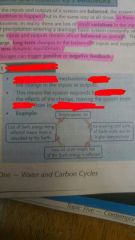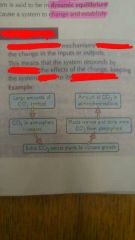![]()
![]()
![]()
Use LEFT and RIGHT arrow keys to navigate between flashcards;
Use UP and DOWN arrow keys to flip the card;
H to show hint;
A reads text to speech;
17 Cards in this Set
- Front
- Back
- 3rd side (hint)
|
Inputs |
When matter or energy is added to the system |
|
|
|
Outputs |
When matter or energy leaves the system |
|
|
|
Stores |
Where matter or energy builds up |
|
|
|
Flows |
When matter or energy moves from one store to another |
|
|
|
Boundaries |
The limits of the system |
|
|
|
Open systems |
Both energy and matter CAN enter and leave an open system-there are inputs and outputs of both |
Drainage basins are open systems- energy from the sun enters and leaves the system. Water is input as precipitation and output as river discharge into the sea |
|
|
Closed systems |
Matter CAN'T enter or leave a closed system- it can only cycle between stores Energy CAN enter and leave a closed system- it can be input or output |
The carbon cycle is a closed system- energy is input (from the sun) and output ( by respiration) but the amount of carbon on Earth stays the same because there are no inputs or outputs |
|
|
Positive feedback |
Mechanisms amplify the change in the inputs or outputs
This means the system responds by increasing the effects of the changr, moving the system even further from its previous state |

|
|
|
Negative feedback |
Mechanisms counteract the change in the inputs or outputs
This means that the system responds by decreasing the effects of the change, keeping the system closer to its previous state |

|
|
|
Crysosphere |
Includes all parts of the Earth system where its cold enough to freeze water |
Glacial landscapes |
|
|
Lithosphere |
Is the outermost part of the Earth. Include the crust and the upper parts of the mantle |
|
|
|
Biosphere |
Is the part of the Earths systems where living things are found. Includes all the living parts of the Earth |
Plants animals birds fungi insects and bacteria |
|
|
Hydrosphere |
Includes all of the water on Earth. It may be liquid form, soild form or gas form. It can be saline or fresh |
|
|
|
Atmosphere |
Is the layer or gas between the Earths surface and space, held in place by gravity |
|
|
|
Peak discharge |
Is the highest point on the graph, when river discharge is at its greatest |
|
|
|
Lag time |
This is the delay between peak rainfall and peak discharge. This delay happens because it takes time for the rainwater to flow into the river. A shorter lag time can increase peak discharge because more water reaches the river during a shorter period of time |
|
|
|
Carbon sequestration |
An umbrella term used to describe the long-term storage of carbon in plants, soils,rock formation and oceans
|
|

